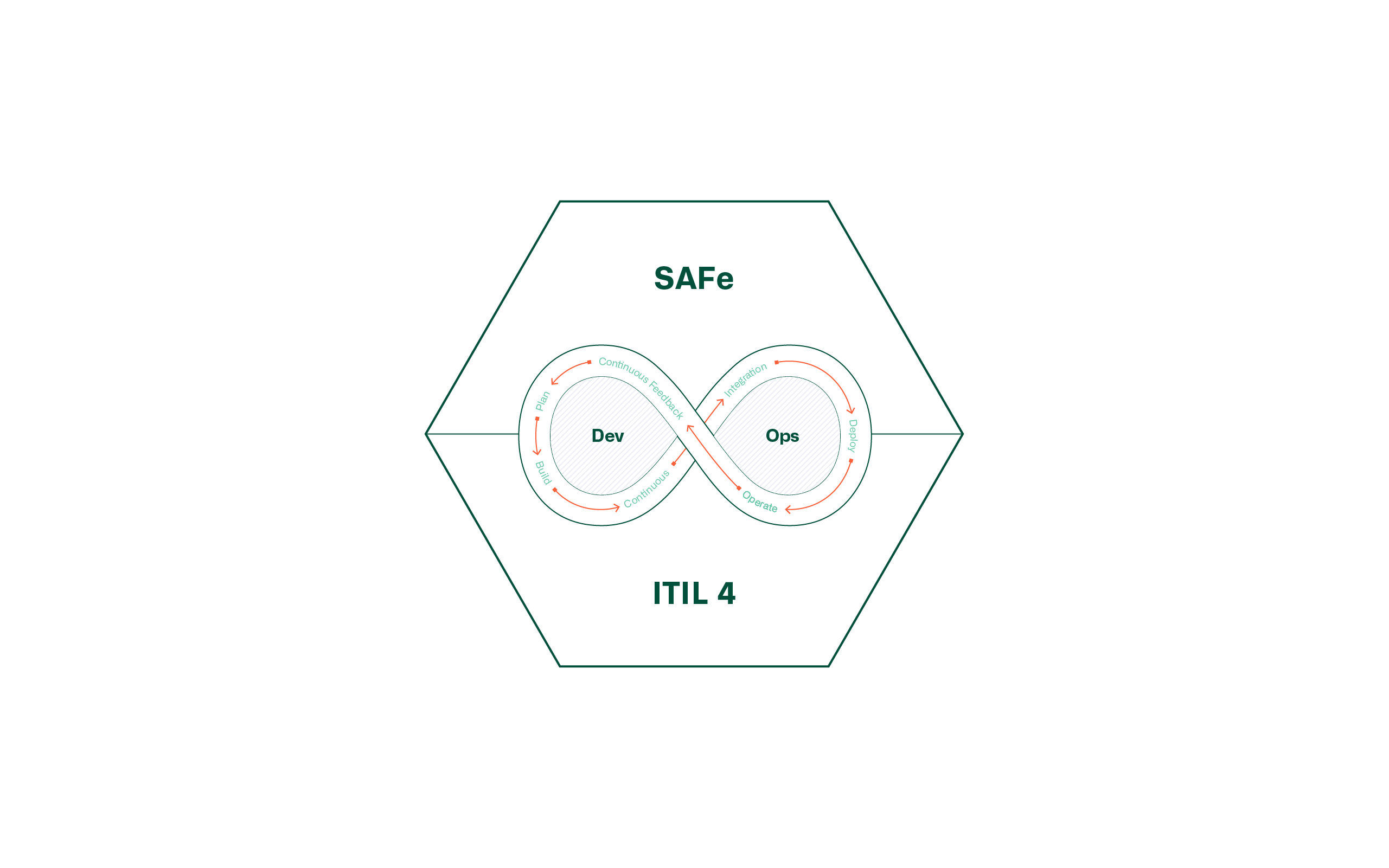Blog
SAFe and ITIL 4 - opposites or symbiosis?
The question is often asked whether the successfully established framework ITIL (Information Technology Infrastructure Library) can be replaced by SAFe (Scaled Agile Framework) in the operational environment.
In contrast to SAFe, ITIL Best Practices offers approaches that describe what needs to be done to achieve a successful IT operating model, but not how to implement it. To support the increasing business requirements for agility in IT value creation as well, ITIL 4 was republished at the end of 2019. ITIL has established itself in the IT environment over the last few years with varying degrees of success. But it is no longer possible to imagine life without it.
What actually is SAFe?
SAFe is a framework that enables companies to implement and scale comprehensive agile structures. SAFe is used to increase productivity and quality with an agile approach. The transparency gained, continuous successes and teamwork enable, among other things, an improvement in the employee environment.
SAFe is designed to help organisations maintain consistent and more efficient value creation on a regular and predictable schedule. It provides a knowledge base of proven, integrated principles and practices to support business agility.
IT Operation with SAFe
IT Service Management or IT Operation is not directly mentioned in SAFe. The whole topic of customer care, operation or support is embedded in SAFe in the whole organisation (methodology), respectively in the value streams.
The whole Value Stream concept is a critical element in SAFe and underlies the Lean Thinking principle. Identifying, visualising and optimising value streams is the primary method a lean company uses to reduce time to market while improving the timeliness, quality and value of its products and services. Each value stream represents the one sequence of steps the company needs to take to deliver value to the customer. These customers can be external as well as internal.
To build IT Operations, SAFe recommends the DevOps approach. DevOps teams can be embedded in the dedicated value streams and thus complete the IT operations tasks more efficiently.
However, if there is already an existing IT Service Management, for example according to ITIL, the company should not discard everything. Instead, the processes, services and organisation should be analysed and optimised in small steps. In this way, the company can always adapt to new circumstances and develop in the direction of agile service management.
In our experience, in some companies, for example, a distinction is made between plannable and non-plannable work. In a support environment, plannable work such as change management or problem management are good examples. Such tasks can be recorded in a backlog, prioritised and processed in sprints.
Non-scheduled work such as urgent customer requests, incidents, etc. usually have a high urgency and cannot be processed in sprints of e.g. 10 days. These non-plannable tasks could be prioritised and processed continuously as agile service management with a method (e.g. Kanban board).
To resume the DevOps thought, developers can divide the resources and work a percentage of their time in the agile teams in development and the other part in the agile teams working on the non-scheduled tasks.
A service desk as an entry gate for customer concerns, whether internal or external, will probably be indispensable in the future. However, a company can constantly analyse and optimise how these enquiries or incidents are handled afterwards.

IT service management becomes agile
With the new ITIL 4 framework, the focus of consideration is placed on - value - costs - risks. The ITIL Value System now describes the chain of activities required to convert a business opportunity or service request into business value.
The Service Value System (SVS) replaces the previous management and life cycle view of IT services. The focus is now on the creation of business value by the IT organisation and its partners, which is referred to as the service value chain. The SVS describes the five key components of value creation and the relationships that exist between them.
Of the five key components, the Service Value Chain is the core element of the Service Value System (SVS) and consists of six generic activities that span the IT service lifecycle or value stream:
The guiding principles in the ITIL 4 framework are the seven guiding principles that ITIL practitioners can and should follow to drive value for their IT organisations. These guiding principles can play an important role in guiding IT decisions and helping IT managers to develop their own strategies and conclusions. The guiding principles are universal and enduring. Referencing is recommended when making decisions. They also belong printed large on the wall of every service manager and practitioner.
It is essential to understand service relationships - value co-creation, i.e. the co-creation of value within a service organisation.
Framework combination for value stream optimisation in IT operations
As described above, ITIL 4 has laid the foundation for applying IT service management in an agile business organisation. In fact, an agile framework is a prerequisite and SAFe, with its possibilities for cross-functional development, offers a way to implement the ITIL framework. Conversely, SAFe does not have precise definitions for an IT operating environment.
Involving the stakeholders from the beginning is a prerequisite. Traditional IT organisations still think in silos and primarily consider only their part of the value chain. The customer perspective was initially taken into account in the service definition, but was lost over time through various adjustments to the organisation and responsibilities. As a result, the individual delivery teams could only focus on themselves and their now incomplete mission. The service value starts with the customer and ends with him.
The DevOps approach in the SAFe framework provides the basis for organisational structures in relation to teams. The goal here is to assign the necessary decision-making powers to the teams by decentralising responsibility. The service value system definitions of ITIL 4 are used to control the structured procedure, taking into account the seven guiding principles and the practices. The aim is to generate value for IT services and products.
No company starts from scratch. It is strongly recommended to continue to use those definitions or practices that have proven themselves and incorporate them into value generation.
When introducing SAFe and/or ITIL 4, the company should definitely also consider which existing methods or frameworks have become established in the company and how these traditional methods are combined with the agile methods.
Another central element from classic IT service management is the service catalogue. The IT and supporting services described in it are valuable achievements and can be transferred into a product portfolio of the agile world. This is an important step towards harmonising the old and new IT service processing and improving and optimising value generation with the agile approach.
Conclusion
Many companies are currently facing or already in the process of such a transition to an agile environment. There are many unanswered questions about how and where to start, how exactly to understand the frameworks, and so on. As in the traditional world, there is no template that can be applied 1:1 to a company.
A practical and pragmatic implementation could look as follows:
We recommend analysing the services, processes, organisation and responsibilities in detail and creating a comprehensible overview. Work out the differentiation through dialogue with the stakeholders and, above all, the IT stakeholders and derive it into what is tried and tested and what is not. Experience has shown that a comprehensive product backlog can be derived from this and forms a qualified starting point.
Implementing agile transformation across the whole organisation at once often involves high risks. To reduce the risk, it would make sense to implement agile in small steps.
According to the agile principles: Start where you are and act iteratively and with feedback.
In order to successfully introduce the frameworks in the companies, we recommend the involvement of experienced coaches.




